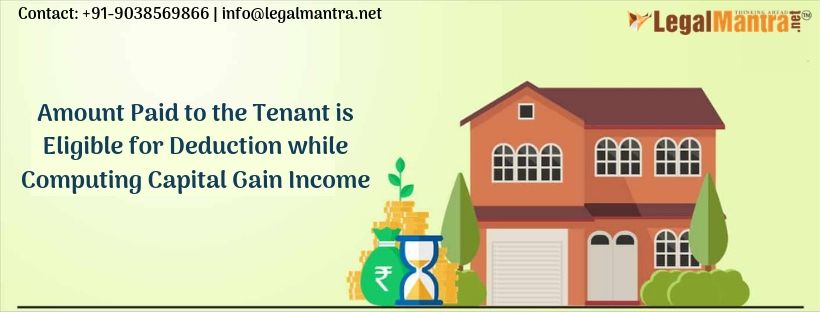View News
Amount Paid to the Tenant is Eligible for Deduction while Computing Capital Gain Income

Naozar Chenoy vs Commissioner of Income-Tax on 22 April, 1998
Equivalent citations: 1998 234 ITR 95 AP
Author: S Maruthi
Bench: S Maruthi, T Rangarajan
JUDGMENT S.V. Maruthi, J.
1. At the instance of the assessee, the following questions are referred by the Tribunal:
“1. Whether, on the facts and in the circumstances of the case, the assessee is entitled to the deduction of the sums of Rs. 43,107; Rs. 34,200; Rs. 60,000; Rs. 63,000 and Rs. 3,800 (in all aggregating to Rs. 2,04,107) as deduction in computing the capital gain on the sale of property belonging to the assessee at Sarojini Devi Road, Secunderabad ?
2. Whether, on the facts and in the circumstances of the case, the assessee is entitled to the deduction of the above amounts aggregating to Rs. 2,04,107 under any of the provisions of the Act or based on the doctrine of real income in computing the assessee’s income chargeable to tax for the assessment year 1983-84 ?”
2. The facts in brief are as follows:
The assessee owned a property at Secunderabad. The said property along with the adjoining property of his sister was sold for a sum of Rs. 30 lakhs. The assessee’s share came to Rs. 18 lakhs. In computing the capital gain on the sale of this property, the assessee claimed certain expenditure which was disallowed by the Income-tax Officer to the extent of Rs. 10,47,000. The disallowance was confirmed in the first appeal. The Tribunal, on a second appeal filed by the assessee, slashed down the disallowance to Rs. 2,22,107. Aggrieved by the same, the assessee sought reference of the questions referred to in the earlier paragraph. The total amount claimed as allowance is Rs. 2,04,107 which consists of Rs. 63,000 which was embezzled by the power of attorney holder who was entrusted with the job of selling the property, Rs. 43,107 being the interest paid on amounts borrowed in connection with the sanction of plans and building permit as per the agreement under which the building was sold ; Rs. 34,200 being the interest paid to Tulsi Narayana Properties for cancellation of agreement ; Rs. 60,000 being the amount paid to the tenant for vacating the premises and Rs. 3,800 being the interest paid to Omkarlal Badruka on the moneys borrowed to repay advances received from earlier proposed vendees. The Tribunal disallowed these amounts on the ground that they have too remote a connection with the transaction and, therefore, the said amounts cannot be allowed.
As regards the amount of Rs. 63,000 which was embezzled by the person who was entrusted with the job to assist the agent of the assessee in selling the property, in the connected R. C. No. 30 of 1990 (Mrs. G.Y. Chenoy v. CIT), we have held that the assessee is not entitled to the deduction of the said amount as she lost the amount in the capacity as an owner and not in the course of the transaction and it is also not incidental to the transaction. As regards the expenditure incurred by the assessee towards payment of the amount to the tenants for vacating the premises, which is the subject-matter of the sale transaction, we are of the view that it has nexus with the transaction as without the tenants vacating the premises, the building cannot be sold. Therefore we are of the view that the said expenditure was incurred for effecting the transaction and therefore he is entitled for deduction of the amounts incurred towards vacation of the tenants, in computing the capital gain of the building sold.
3. It follows from the above that the assessee is entitled to the deduction of Rs. 43,107, Rs. 34,200, Rs. 60,000 and Rs. 3,800 because these amounts relate to the expenditure incurred for the purpose of getting the tenants to vacate the building. Accordingly, we allow the same.
4. Regarding the amount of Rs. 63,000 embezzled by the person who was assisting the agent of the assessee for selling the building, the assessee is not entitled to deduction.
5. In the light of the above, we answer the questions partly in the affirmative and partly in the negative, that is, partly in favour of the assessee and partly against the assesses.
6. The reference is answered accordingly.

